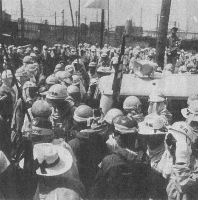 |
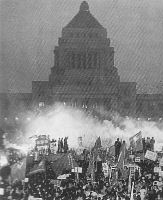 |
| The Miike miners, their families, and sympathizers fought hard against "capitalists" but they lost. | Protestation against the government over the renewal of the Japan-US Security Treaty. |
(See Handouts nos.9-11)
After the recovery period of 1945-49 and the Korean War in 1950-53, the Japanese economy entered into a period of high growth. From the mid 1950s to the early 1970s, the average real growth was roughly 10%. This very high and sustained growth transformed the Japanese economy and society significantly. By around 1970, Japan overtook West Germany and became the second largest economy in the capitalist world measured by GNP size (No.1 was of course America). Japan's catching-up process with the West was finally over. There are many issues to be discussed for this very interesting period. Our lecture will focus on the following five topics:
"Rationalization"
Macroeconomic management
Industrial policy
Global re-integration
Social change
Let us also briefly preview the entire postwar period up to the present.
In the 1970s, Japanese growth slowed down considerably. The apparent reasons for this were the two oil shocks (1973-74 and 1979-80); the breakdown of the Bretton Woods fixed exchange rate system (see below); and the maturity of the Japanese economy. It is also important to remember that the growth rates of all major industrial countries fell at that time. It was not a phenomenon unique to Japan.
In the 1970s and 80s, the Japanese economy grew at an average rate of about 4%. The government called this "stable" growth. Japan's current account became persistently in surplus from the late 1960s (except during the two oil shocks). With medium-term cycles, Japan's surplus ballooned significantly, causing friction with the US and Europe. The major currencies (dollar, ecu, yen) continued to float and became quite unstable at times. The Bank of Japan often intervened to curb the yen's excessive appreciation (i.e., buy up dollars). As a result, international reserves accumulated considerably to the highest level in the world. In 1985, the Group of Five (G5) countries seriously began to intervene jointly in the currency market to lower the overvalued dollar (the Plaza Agreement). In 1987, the framework was expanded to the Group of Seven (G7, the Louvre Accord). The loose regime of floating major currencies with occasional joint intervention still continues today.
Japan had an asset bubble (in stock and land markets) in the late 1980s. It burst in 1990-91 and the Japanese economy deflated. In the 1990s, real growth remained very low, sometimes even negative. In 1996 and 2000 the economy showed signs of recovery, but it failed to materialize. In 2004, we have a sign of recovery again but still do not know if it will be a sustainable one.
Now we go back to the 1950s and 60s.
During the preceding period of 1945-49 when economic planning was still in place, the principal objective was quantitative recovery. At that time, the Japanese economy was virtually closed to international trade. The recovery policy was pursued at any cost, ignoring efficiency. Subsidies, fukkin loans and US aid were provided.
But in the early 1950s, after the Dodge Line stabilization, the Japanese economy entered another phase. The new situation can be described as follows.
--Control and subsidies were abolished and the market mechanism was largely restored.--Private international trade began (but it was not free trade yet; past legacies such as exchange control, import protection, foreign currency surrender requirement and administrative guidance were still in place).
--There was a global inflation associated with the Korean War. But the Japanese inflation was higher than the world average: between 1949 and 1951, Japanese WPI rose 64% and CPI rose 8.5%. During the same period, WPI inflation in the US and UK was 16.1% and 11.1%, respectively.
--The new fixed exchange rate of $1=360 yen was established in 1949. This level was considered appropriate initially, but with the Korean War inflation, it became overvalued.
--Japan regained political independence (San Francisco Peace Treaty, 1951) and US economic assistance ended. With the Japan-US Security Treaty (1951, revised 1960), Japan became a US ally in the Cold War.
--Japan had only small international reserves ($567 million at end 1950).
Under these new circumstances, Japanese industries now had to strive for efficiency and competitiveness. The days of economic planning and physical expansion were over, and the challenge for cost reduction and higher quality began.
Before the Korean War began (June 1950), Japanese industrial costs were roughly in line with those in the US. But two years later (June 1952), most of the industrial inputs became more expensive than in the US. In particular, coal and steel were among the most expensive. These were precisely the two products targeted by the Priority Production System in 1947-48 ! The "problem of high prices of coal and steel" reduced the competitiveness of all other industries that used them as inputs.
To cope with overvaluation and the loss of competitiveness, three policy options were theoretically possible: (i) yen devaluation; (ii) macroeconomic austerity to generate deflation; and (iii) improvement in productivity. Japan mainly chose the third option. The option (ii) was also partly adopted, but option (i) was not considered. Japan had just overcome the postwar confusion, unified exchange rates in 1949, and regained political independence in 1951. Under the Bretton Woods fixed exchange rate system, Japan felt that it was unacceptable to revised the newly installed exchange parity so soon.
"Rationalization" (gorika) means improving productivity through investment in new machinery and technology, and reorganizing production and management. This became a national economic goal in the early 1950s. During the Korean War, many companies enjoyed the US military procurement boom and accumulated profits. These profits were the main financial source for introducing new technology and machines. However, labor unions often opposed rationalization because they thought this slogan was used as an excuse to lay off workers.
Some industries succeeded in rationalization but others failed and declined. As to coal and steel, the former was a loser and the latter was a winner. Both contributed to a rise in overall productivity--the one by disappearing and the other by becoming competitive. The coal industry was especially hard hit because the world energy source shifted dramatically from coal to oil, which was cheaper. Unlike coal, Japan had to import 90% of oil because its domestic supply was severely limited.
The government's role was also significant in industrial rationalization. In 1953-54, as imports surged and Korean War military procurement declined, Japan faced a balance-of-payments crisis. The Bank of Japan raised interest rates and the budget and the fiscal investment and loan program (FILP) were tightened. The policy intention was to lower inflation to near zero (finally!) and encourage industries to reduce costs further. This policy is entirely different from the one adopted after the WW1 boom in the 1920s. At that time, weak companies and banks were rescued. Now, they were asked to become more efficient or exit. After an artificial boom, it is possible that certain austerity is needed to prepare for the next period of sustained high growth.
Another important fact is that new instruments of industrial policy were created during the early 1950s. To replace the price controls, subsidies and fukkin loans of the early recovery period, the following new policy tools were introduced:
--Foreign exchange budget
--Capital control (including control of technology imports)
--Preferential tax treatment for specific industries
--Creation of the Japan Development Bank and other policy banks
--A number of laws for promoting enterprise rationalization
Equipped with these policy tools, the Japanese government was now ready to help industries.
The year 1960 was a dividing year in postwar Japan. In that year, the Miike coal mine strike climaxed (this mine was located in Kyushu and held by the Mitsui Group). Coal miners protested against the selective laying-off of workers (labor union leaders) and occupied the hopper facilities. This was considered a fight between all capitalists and all workers in Japan, but the miners lost. Another big event in 1960 was a renewal of the Japan-US Security Treaty. The Kishi Cabinet (Liberal Democratic Party or Jiminto) tried to force it through the parliament despite nationwide protest against it. A huge demonstration was staged which surrounded the Diet (parliament) building and one female student was killed. But the treaty was renewed and the government resigned for causing the mess. With these two events, the days of direct confrontation in ideology and politics were over. The new LDP government led by prime minister Hayato Ikeda refocused national attention from politics to economics by proposing the "Doubling Income Plan" He proposed to double Japan's GNP in ten years which required an average growth of 7.2% annually. Japan actually grew faster than this and Ikeda's goal was achieved sooner than expected. Political radicalism was gradually replaced by a more cooperative management-labor relationship.
The two major events in 1960
 |
 |
| The Miike miners, their families, and sympathizers fought hard against "capitalists" but they lost. | Protestation against the government over the renewal of the Japan-US Security Treaty. |
During the 1950s and 60s, macroeconomic management had the following features.
The budget was generally sound and in surplus. This was particularly true for the central government. In addition, the government size was gradually reduced, especially during the 1950s. Monetization of fiscal deficits were prohibited. In fact, no government bonds were issued until 1965 (for this reason, there is no statistics on government bonds before then).
On the monetary side, the fixed exchange rate of $1=360 yen was maintained from 1949 to 1971. The Bretton Woods system permitted occasional realignment of the exchange parity, but Japan never considered it. Some people say the yen became gradually undervalued in real terms, because Japanese productivity growth was higher and its cost became lower compared with the rest of the world. But this conclusion may be debatable (see McKinnon and Ohno, 1997).
A fixed exchange rate constrained the use of monetary policy. In other words, monetary policy was no longer an independent policy variable. This is called the "endogeneity" of monetary policy under a fixed exchange rate. Once the yen/dollar rate was fixed, the Bank of Japan had to adjust its policy toward this goal. Specifically, this policy constraint was imposed as follows.
Since there was no free capital movement at that time, a balance-of-payments (BOP) deficit basically meant a trade deficit. When the domestic economy overheated and imports surged, the Bank of Japan tightened money by raising short-term interest rates and through "window guidance" (telling commercial banks to reduce new loans). Since Japanese firms depended heavily on bank loans, this immediately lowered investment. Overheating was eliminated and the BOP pressure eased. Every time the economy overheated, the Bank of Japan had to adopt this policy. This was called the "balance-of-payments ceiling" or "stop-go policy." This was practiced until the mid 1960s.
To cope with the BOP pressure under a fixed exchange rate system, West Germany intervened in the foreign exchange market and revalued the Deutsche mark occasionally (there was always an upward pressure on DM). In contrast, Japan chose macroeconomic austerity (especially tight money) for adjustment. Thus West Germany accumulated international reserves but Japanese reserves were stable until the mid 1960s (after that, the Bank of Japan began to intervene aggressively and accumulated dollar assets).
Under this monetary regime, WPI was virtually constant. From 1951 to 1971, it rose at an annual rate of 0.7% This remarkable price stability was also experienced in the US and West Germany. This was a period of historically unprecedented global price stability. Japan "imported" this global price stability in tradable goods by maintaining a fixed exchange rate. CPI rose a bit faster, at an annual 4.4%. This was considered a problem ("creeping inflation"). During the same period, nominal wage rose 10.2%, nominal GDP rose 14.5%, and M1 rose 15.9% (all in annual average). The inflation gap between WPI and CPI can be explained by the Balassa-Samuelson effect (also called the Scandinavian model of inflation--see handout no.10).
Meanwhile, real GDP rose by an average of 9.4% per year during 1951-71.
Japan joined the World Bank in 1952 and began to borrow from it in the following year. It soon became the World Bank's second largest borrower (after India). Japan continued to borrow from the World Bank until 1969. All World Bank loans were used for building infrastructure (no poverty alleviation, education or other social sector purposes). World Bank loans were made to the Japan Development Bank which on-lent them to industries (called "two-step loans"). But World Bank loans occupied less than 1% of total domestic investment. Japan financed its vigorous investment in this period almost entirely through domestic saving. There was virtually no receipt of FDI, let alone portfolio investment. But technology imports were very actively promoted.
The Ministry of International Trade and Industry (MITI) was created in 1949 by merging the ministry of agriculture and trade, the ministry of trade and industry, the coal agency, and the trade agency. Later in 2001, MITI was renamed to the Ministry of Economy, Trade, and Industry (METI).
During the mid 1950s to the early 1970s, MITI played a role. But economists still debate the importance of MITI's role. High growth was achieved because of MITI or despite it? Some say MITI's policies were crucial, while others say they were a negative factor but private dynamism overpowered it. Still others say MITI's role was insignificant or neutral. Some industries succeeded without official promotion (consumer electronics, camera, motorbike, piano, watch, calculator, etc). Other industries failed even with official support (coal, aluminum refining, nuclear fusion, computer, etc). MITI tried to merge automobile companies prior to trade liberalization because domestic producers were considered too numerous and too small to compete with the American giants. But the automobile industry refused MITI's initiative (and they did very well subsequently).
There are also econometric studies on the effectiveness of MITI policies, but the results remain inconclusive and depend on the data and the researcher. Some studies examined whether targeted industries on average had higher growth than those without support. But some industries received support for downsizing, and underlying growth rates differed across industries, so such a test is not a fair evaluation. Econometrics on industrial policy is extremely difficult due to the impossibility of constructing a convincing "counter-factual" (how Japanese industries developed if MITI did not intervene).
The World Bank previously denied the role of selective industrial policy but its East Asian Miracle report (1993) partly recognized its merits (only for Japan, Taiwan and Korea, though). The 1997 World Development Report further recognized the possibility of industrial policy for countries with strong institutions. My personal view is that private dynamism was primary but policy also played a useful positive role in Japan (this conclusion also applies to the earlier Meiji industrialization).
The Japanese government mobilized industrial promotion measures which were also widely practiced elsewhere in the world: preferential taxes, subsidies, low-interest policy loans, R&D assistance, SME promotion, entry restriction, coordination of output, investment and exports, building infrastructure, and so forth. Local contents requirement on foreign companies was unnecessary and irrelevant since Japanese growth did not depend on FDI.
In addition, MITI had a set of softer instruments for sharing information among various stakeholders: setting visions and targets, shingikai (deliberation councils), business groups, administrative guidance, human networks, and so forth. For more details, see Johnson, Okimoto, and Komiya et al in the reference list.
Industries were chosen for promotion by the income elasticity criterion and the productivity criterion. In other words, industries with growing demand and high productivity growth were selected. But this sounds a bit too obvious. The real question was how to do this, more concretely (collecting information, forecasting demand and competition, evaluating future possibility, etc). I don't think MITI had relied on any econometric model to choose industries.
There are other theoretically interesting issues concerning the industrialization in the 1950s and 60s.
Excess competition--some people say excess competition is a contradictory phrase, since to them the fiercer the competition, the better. But competition can be excessive if markets are undeveloped, if information on quality is lacking, or if the industry exhibits increasing returns.Infant industry promotion--this is a classical theory of industrialization from the 19th century onward. Again, increasing returns or the learning effect can justify infant industry promotion. But neoclassical economists argue that, in practice, governments are incapable of choosing the right industries or resisting political pressure (this type of argument against protection is called the political economy of protection).
See handout 10 for more explanations on these. Some economists think these ideas are already discredited and outdated in the age of WTO and free capital mobility, but many Japanese development economists do not think so.
Japan took the following steps to re-integrate itself into the global economy.
| 1951 | US occupation ends; political independence restored |
| 1952 | Japan becomes a member of the IMF and the World Bank |
| 1955 | Japan joins GATT (however, many countries refused to grant full trade rights to Japan and trade discrimination against Japan continued) |
| 1956 | Japan joins the United Nations |
| 1964 | Japan joins OECD; IMF Article 8 status (no exchange restriction for current-account transactions); the Tokyo Olympics (hosting Olympic games often works to accelerate growth and boost national pride) |
| Late 1960s | Tariff reduction implemented |
The market mechanism was restored by the Dodge Line stabilization (1949), but this did not mean a completely free economy. On the contrary, many policy measures continued to regulate the markets. One of them was import protection. Japan's trade barriers had remained high since the pre-WW2 period. In the 1960s the government decided to lower them in an effort to rejoin the world economy and implement the GATT Kennedy Round commitments. This was also necessitated by political and diplomatic reasons.
Japan's trade liberalization in the 1960s was (i) gradual and well planned; (ii) linked with industrial promotion measures; and (iii) using international commitments to avoid domestic political capture. It was carried out with a very strong ownership of the Japanese government and business community. Since pre-committed trade liberalization goals were nonnegotiable, producers concentrated their efforts on improving efficiency rather than lobbying for the extension of protection for survival. Official support was provided according to actual performance (including export volume). Domestic firms competed fiercely with each other, but the competition was coordinated by the government so few firms went bankrupt. In this way, competition and cooperation coexisted. Prof. Yasusuke Murakami called this situation "compartmentalized competition."
This is probably the ideal way to implement trade liberalization. But its execution required a very high institutional capacity. For most countries, it is not easy.
While trade barriers were gradually reduced, capital control was not abolished during the high growth period. It was removed step by step from the 1970s onwards. The most important step in liberalizing capital transactions was the Foreign Exchange Law of 1980 (much later than the period we are discussing).
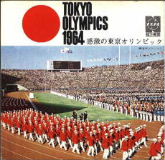 |
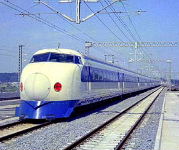 |
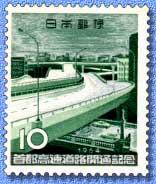 |
| Three events in 1964: Tokyo Olympics, opening of the Tokaido Shinkansen superexpress (Tokyo-Osaka), and the opening of Shutoko (Tokyo Metropolitan Expressway). World Bank loans were used to build both Shinkansen and Shutoko. | ||
Economists still argue about the true cause of high growth in the 1950s-60s. Some say it was vigorous investment. Others say it was export-driven. Some Keynesian economists, like Prof. Hiroshi Yoshikawa (Tokyo University) believe it was strong consumption. I think it is very difficult to single out one cause since all were interrelated.
At any rate, the consumption boom was certainly a very prominent feature of the high growth era, whether it was the cause or the effect. In the late 1950s, all consumers wanted to purchase washing machine, refrigerator, and black & white TV (these were called "three divine devices"). In the 1960s, color TV, car, and "cooler" (air conditioner) attracted everyone's attention (they were called "three C's"). As markets and production scale expanded, costs and prices declined, which in turn further stimulated demand. The mass production system also generated the white-collar middle-class who purchased these goods. This virtuous circle continued until the early 1970s.
Before the high growth era, the basic life style of the Japanese people (food, clothing, housing) changed very slowly. Before WW2, most people generally ate Japanese food (rice, miso soup, pickled vegetables, fish, natto beans, sake...), wore Japanese kimono, geta (wooden sandals) and zori (Japanese sandals), and lived in wooden houses with paper sliding doors. People slept on tatami mats with futon. But all this changed dramatically during the 1960s. Bread, coffee and western food became common. Very few people now wear kimono (except in New Year and on special occasions). Concrete-built apartments with blinds and curtains became popular. Urbanization progressed. Big families were replaced by nuclear families. Individualism began to replace group-orientation. Among all periods in Japanese history, perhaps the high growth era brought the greatest changes in life style.
Japanese Life Style before the High Growth Era
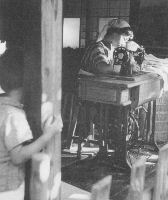 |
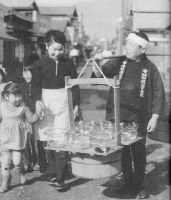 |
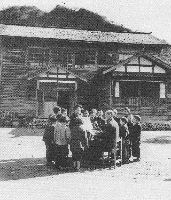 |
| Making family clothes with a foot-pedaled sewing machine (1955) | A gold fish seller on a Tokyo street (1956) | A primary school building made of wood (1954) |
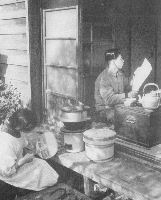 |
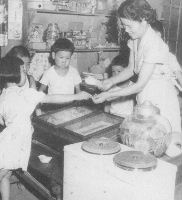 |
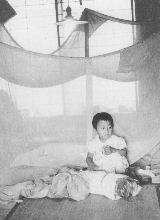 |
| The husband reads the newspaper while the wife cooks with a portable charcoal stove (1949) | Children buy candies with allowances from parents (1953) | Sleeping under a mosquito net (1956) |
For a long time, labor surplus persisted and wages remained depressed in the Japanese economy. But the high growth brought a critical change. Around 1960, labor surplus turned to labor shortage. The so-called "turning point" was reached in the Arthur Lewis model (handout no.11). Special trains were prepared to transport graduates from middle or high schools in the rural areas to big cities as new workers. As the labor market tightened, these young workers were called "golden eggs."
During the high growth period, environmental destruction caused by rapid industrialization became intolerable. Water and air quality deteriorated. People's grass-roots movement rose against commercial irresponsibility and official negligence, culminating in the four principal lawsuits against public hazard.
|
Four Major Pollution Lawsuits of Postwar Japan |
|
| Minamata disease (Minamata City, Kumamoto Prefecture) |
--First reported in 1956. --Water pollution by organic mercury by the Chisso Corporation. --Numbness, speech disturbances, narrowing of field of vision, mental disorders, loss of muscle coordination and other neurological disturbances. |
| Itai-itai disease (Jintsu River, Toyama Prefecture) |
--First reported in 1955. --Water pollution by cadmium emitted by the Kamioka Refinery of Mitsui Mining & Smelting Company. --Severe pain. "Itai-itai" means "it hurts, it hurts." |
| Niigata minamata disease (Agano River, Niigata Prefecture) |
--First reported in 1965. --Water pollution by organic mercury by the Showa Denko Company. --Same disturbances as minamata disease. |
| Yokkaichi asthma (Yokkaichi City, Mie Prefecture) |
--The petrochemical complex started operation in 1960. --Air pollution by SOx and other chemical substances. --Sore throats, coughing, respiratory organ troubles, vertigo, nervous diseases, eye irritation. |
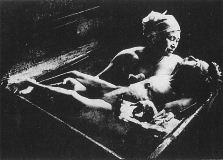 |
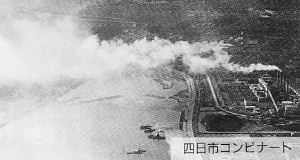 |
|
The award winning photo of a minamata disease victim. |
The sky over Yokkaichi City in the 1960s. |
Politically, two conservative parties merged to become the Liberal Democratic Party (LDP) in 1955, and dominated Japanese politics ever since (it lost the prime minister's seat during 1993-96, but regained it after that). This political situation, with the powerful and conservative LDP and the weak opposition parties, was called the "1955 Regime." In many senses, LDP is much like Seiyukai in the prewar period. Its support base is rural. LDP distributes public money for rural investment and farm subsidies. With the coming of prime minister Kakuei Tanaka (in office during 1972-74), this political style of LDP--rural money politics for winning votes--was firmly established, and it still continues today. Many LDP politicians want to continue building Shinkansen and highways despite the severe budget crisis (Mr. Koizumi says he hopes to reform this...)
Mr. Soichiro Honda: The Postwar Business HeroThe postwar Japan produced many business heros. Among them, Mr. Soichiro Honda (founder of Honda Motor Company), Mr. Konosuke Matsushita (founder of Matsushita Electric Industrial Company, with brand names National and Panasonic) and Mr. Masaru Ibuka and Mr. Akio Morita (founders of Sony) are particularly famous. They were all engineer-type inventors, who began with a tiny factory with great vision and desire to produce new and better things to conquer the Japanese--and world--market. They were driven by the monodukuri (making things) spirit, not by high salaries, quarterly profits or balance sheets. After achieving a big success, each of them became interested in the non-business world including education, culture, environment and economic diplomacy.
Soichiro Honda was a son of a blacksmith in Shizuoka. When he was a boy, he learned the techniques of bellowing, using furnace, and casting from his father. From early on, he was crazy about mechanics. When the father opened a bicycle shop, Soichiro helped him as a repairman. After finishing the secondary school, Soichiro worked for an automobile repairing company. After six years, he was permitted to head the company's Hamamatsu branch when he was 21. He was not satisfied with just repairing automobiles, so he started to experiment and create new parts. In those days, virtually all cars were imported, and domestic production of parts was an important goal for the industry. Soichiro tried to produce piston rings (crucial engine part) by himself, but it was not easy. After realizing that experience must be combined with theory, he studied metal and mechanical engineering at Hamamatsu Technical School. After the war defeat, Soichiro established a new company for producing motorbikes which later became Honda Giken Kogyo (English name: Honda Motor Company). Honda's first motorbikes--DREAM (146cc) and CUB (50cc) were big hits. Around 1954, Honda faced crisis due to fierce competition and technical problems with its products, but the crisis was overcome by the effort of Takeo Fujisawa, the marketing manager. Soichiro wanted to participate--and win--the Tourist Trophy (TT) in UK (an international motorbike race). He created a special team to manufacture a powerful motorbike for this race. In 1959, Honda first participated in TT; and in 1961, Honda achieved complete victory in TT by winning 1st to 5th prizes in both 125cc and 250cc classes. At the same time, Honda introduced Super Cub, a popular 50cc motorbike with an efficient engine. It became an even bigger hit with consumers. In the 1960s, Honda began to produce automobiles (this move was accelerated by the MITI's plan to consolidate Japanese auto makers to compete with America. If implemented, newcomers like Honda would be excluded, so Honda rushed to enter this market). The first popular small car, N360, sold well but was later criticized as defective. In 1970, a tough environmental law was enacted in the United States requiring automobiles to drastically reduce emissions. Honda became the first auto maker in the world to clear this tough standard in 1972 with its newly invented CVCC engine. This proved that Honda had the highest technology in automobile as well as in motorbike. It also stimulated the other Japanese auto manufacturers into producing fuel-efficient low-emission cars. <Words of Soichiro Honda>
|
<References>
Chalmers Johnson, MITI and the Japanese Miracle: The Growth of Industrial Policy, 1925-1975, Stanford University Press, 1982.
Komiya, Ryutaro, Masahiro Okuno and Kotaro Suzumura, eds, Industrial Policy of Japan, Academic Press(1988).
Kosai, Yutaka, En no Sengoshi (The Postwar History of the Yen), NHK Ningendaigaku Textbook, 1995.
McKinnon, Ronald I., and Kenichi Ohno, Dollar and Yen: Resolving Economic Conflict between the United States and Japan, MIT Press, 1997. Also available in Japanese translation (Toyo Keizai 1998)
Miyamoto, Matao, Nihon no Kindai 11: Kigyokatachi no Chosen (A History of Modern Japan vol.11: Challenges of Entrepreneurs), Chuo Koron Shinsha, 1999.
Murakami, Yasusuke, Shin Chukan Taishu no Jidai (The Age of New Middle Mass), Chuo Koronsha, 1984.
Okimoto, Daniel I., Between MITI and the Market, Stanford University Press, 1989.